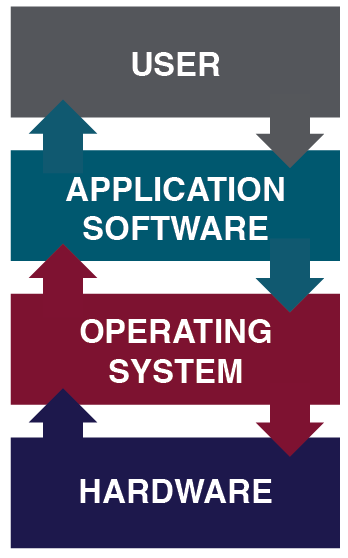4.2. Operating Systems

Software can be broadly divided into two categories: Operating Systems and Application Software.
Operating systems manage the hardware and create the interface between the hardware and the user. Operating systems are designed to create a platform so that programmers can write additional applications, allowing the computer to do even more useful things. Application software (sometimes referred to as software applications, applications or even just apps) performs specific tasks for the user.
Operating Systems
An operating system is first loaded into the computer by the boot program, then it manages all of the programs in the computer, including both programs native to the operating system such as file and memory management and application software. Operating systems provide you with these key functions:
- Managing the hardware resources of the computer;
- Providing the user-interface components;
- Providing a platform for software developers to write applications.
All computing devices require an operating system. The most popular operating systems for personal computers are: Microsoft Windows, Apple’s Mac OS, and various versions of Linux. Smartphones and tablets run operating systems as well, such as iOS (Apple), and Android (Google).
Microsoft provided the first operating system for the IBM-PC, released in 1981. Their initial venture into a Graphical User Interface (GUI) operating system, known as Windows, occurred in 1985. A GUI provides the way a user interacts with a program on a computer. It is what gives a program its look and feel. Today’s Windows 10 supports the 64-bit Intel CPU. Recall that “64-bit” indicates the size of data that can be moved within the computer.
Apple introduced the Macintosh computer 1984 with the first commercially successful GUI. Apple’s operating system for the Macintosh is known as “Mac OS ” and also uses an Intel CPU supporting 64-bit processing. Mac OS versions used to be named after mountains (such as El Capitan) and are now named after locations in California. The most recent version is called Monterey. Multitasking, virtual memory, and voice input have become standard features of both operating systems.
The Linux operating system is open source, meaning individual developers are allowed to make modifications to the programming code. Linux is a version of the Unix operating system. Unix runs on large and expensive minicomputers (computers that are smaller and less powerful than a mainframe or supercomputer but more expensive and more powerful than a personal computer). Linux developer Linus Torvalds, a professor in Finland and the creator of Linux, wanted to find a way to make Unix run on less expensive personal computers. Linux has many variations and now powers a large percentage of web servers in the world.
Why Is Microsoft Software So Dominant in the Business World?
If you’ve worked in business, you may have noticed that almost all computers in business run a version of Microsoft Windows. Many businesses used IBM mainframe computers back in the 1960s and 1970s. When businesses migrated to the microcomputer (personal computer) market, they elected to stay with IBM and chose the PC. Companies took the safe route invested in the Microsoft operating system and in Microsoft software/applications.
Microsoft soon found itself as the dominant personal computer operating system for businesses. As the networked PC began to replace the mainframe computer, Microsoft developed a network operating system along with a complete suite of programs focused on business users. Today, Microsoft’s desktop operating system, Windows controls 71% of the market, and their productivity software, Office 365, has 48% of the market share (Liu, 2021).
“Chapter 3: Software” from Information Systems for Business and Beyond (2019) by David Bourgeois is licensed under a Creative Commons Attribution-NonCommercial 4.0 International License, except where otherwise noted

